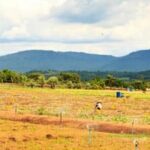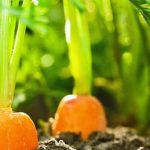Introduction
Backyard gardening has become increasingly popular in recent years as people realize the many benefits, from personal satisfaction to increased access to healthy produce. Growing your own fruits and vegetables, even in a small space, can provide delicious and nutritious food for your family and save you money on groceries. It also gives you the opportunity to be creative with the spaces available and grow something different or unique. Here are some tips for getting started and growing a successful backyard garden.
1. Choose what type of garden to grow: Decide between raised beds, traditional rows, containers or vertical gardens. Think about the amount of space you have available and what kind of soil you’re working with.
2. Pick the right plants: Decide which fruits & vegetables you would like to grow in your garden – think heirloom varieties if possible! Consider how much sun exposure they need, as well as their yield size and how much care they require (e.g., will they need pollination?).
3. Start off small: There’s no need to go overboard when starting out your backyard fruit and vegetable garden; it’s best to start small so everything isn’t too overwhelming. Start by planting just a few things you know will do well and that you’ll enjoy eating- being successful right away is key!
4. Prepare your soil: Before planting anything, get an understanding of what kind of soil is already in place- sandy? heavy clay? acidic/alkaline levels? Raised beds can help improve drainage if needed and adding organic matter (such as compost or manure) is essential for feeding plants’ root systems over time & while they’re developing larger roots & yields!
5 Plant at the right time: Planting at the right time of year matters – depending on where you live this may mean waiting until it warms up enough or waiting through frosts if needed so those cold weather crops don’t suffer too much damage! Take advantage of longer daylight hours for fruits (not just better butternut squashes!).
6 Water regularly & use mulch: To keep plants hydrated & healthy during hot summers/cold winters make sure water them every day/regularly throughout growing months as necessary depending on temperature/humidity levels– using mulch around the base can help retain moisture better too!
Benefits of Growing Your Own Fruit and Vegetables
Health Benefits: Growing your own fruit and vegetables is a great way to stay healthy. Not only are you controlling what goes into the food production process, you’re also getting a freshness that can’t be matched in stores. In addition to this, homegrown produce has higher concentrations of vitamins and minerals than store-bought produce, and it doesn’t contain the same level of pesticide or herbicide residue that comes with many conventionally produced fruits and vegetables.
Environmental Benefits: Growing your own produce helps relieve some of the pressure on resources placed by large scale commercial farming. It also helps reduce pollutant runoff from synthetic fertilizers as well as lower transportation needs by reducing artificial shipping of foods across long distances. Additionally, composting natural garden waste reduces the amount of landfilled waste that ends up decaying in oxygen deprived environments, releasing methane and other greenhouse gases into the atmosphere.
Financial Benefits: The cost savings associated with growing your own fruits and vegetables can be quite significant over time compared to buying them at the store. On top of this, homegrown produce often fetches a premium price when you are ready to sell! Finally, if you have extra room in your backyard or garden there are almost always ways to get an added benefit out of it (beekeeping, aquaponics, etc.).
Get Started
Before you get started on your backyard vegetable and fruit garden, it’s important to acquire the basic supplies and equipment. The most important items are a trowel, rake, hoe, spade, and gloves. If you plan on doing organic gardening with composting and plant care without the use of chemical pesticides, consider getting nutrient-rich soil amendments such as mulch or compost for nourishing plants. As for seed starting supplies, you’ll need seed trays, flats and starter cubes to help your seeds start growing. You may also want to purchase specialty tools such as bulb planter or cultivator depending on what types of vegetables and fruits you’re planning to grow.
Once you have all the necessary items for your garden, it’s time to prepare the perfect spot! Start by cleaning up the area so that it is free of any weeds or debris. Dig out any rocks in the soil before turning over the earth with a pitchfork or tiller. Once the soil is ready to be worked on, use nutrient-rich fertilizer or compost to give your plants a boost of nutrition right away. To ensure proper drainage at planting time, dig basins around each hill of soil that can collect any excess water while also providing aeration in between each hill/plant area. If you start from seeds rather than from transplants, clear away enough space in each designated planting area for placing rows evenly apart so that they’re not overcrowded when fully grown. Lastly, install trellises or frames for taller climbing fruit and vegetable vines in order to keep them off the ground and supported properly during growth and production.
Gardening Basics
When creating a backyard fruit and vegetable garden, there are some important facts and practices to consider. Firstly, it is important to choose plants that contribute to the overall aesthetic of your outdoor space. Consider the color of flowers, texture of leaves, and size of vegetables when making plant selections. Secondly, make sure to properly prepare the soil for gardening by adding organic compost and fertilizer to improve the nutrition and acidity levels in the earth. Thirdly, water your plants regularly but do not overwater as excess water can cause root rot. Lastly, check frequently for pests that can damage or ruin plants. If necessary use natural insect repellents or introduce beneficial insects such as ladybugs or praying mantis that will consume harmful pests but leave our fruits and veggies alone. Following these basic steps will help ensure an abundant harvest of delicious homegrown produce!
Planting Ideas
When choosing plants for a backyard fruit and vegetable garden, the right type of plant to choose depends on the location and the season. For instance, some vegetables such as tomatoes may require full-sun while shaded areas may be better suited to growing salad greens. Depending on the time of year, those looking to create a vegetable garden should consider starting with cool-weather crops such as kale or spinach in early spring and following up with warm-weather items like peppers or pumpkins in late summer.
When it comes to fruits, berry bushes can produce good harvests from early summer well into autumn. Strawberries are one of the most common and easy types to grow, but blueberries also provide a sweet treat from May onwards. Some apple varieties can also do well in backyards leading up to harvest time in October. When selecting plants for a backyard fruit and vegetable garden make sure not only to pick items that are local or suitable for the climate but also those that ripen at different times so you can enjoy fresh produce throughout the year.
Pest Control
One of the best ways to protect your backyard fruit and vegetable garden from pests is to prevent them in the first place. Make sure your garden space is not too crowded, as this can encourage pests or disease. Plant pest-resistant varieties of fruits and vegetables when available, as these have reduced susceptibility to certain types of insects. Keep your garden clean and free of weeds, as these can host pests. Give your plants enough water so that their leaves are healthy, because a dry plant is more susceptible to attack by insects and other pests.
In addition to prevention measures there are several ways you can manage any upcoming threats from pests in your garden. Biological pest control involves releasing beneficial organisms such as ladybugs into the garden which will predate on most harmful insect populations. Insecticides are another option for treating existing pest problems if you feel it necessary. However, make sure to use the product correctly according to its label instructions; using too much can be dangerous not just for the environment but also for humans and desirable insects such as bees or butterflies in the garden habitat. Finally, physical removal of some pests such as caterpillars can help keep populations down without resorting to chemicals or introducing new species which could disrupt the already established ecosystem within your garden
Plant Care
Pruning is an important part of garden maintenance. Pruning helps to promote bushier and healthier growth in plants. Deadheading, or removing spent flowers, can help encourage more blooms throughout the season. Trimming back branches that grow too long or spread out too far can also help keep the plant healthy and better produce flowers or vegetables.
Fertilizer is essential for your fruit and vegetable garden since the soil can quickly become nutrient-deficient. Consider using organic fertilizers such as manure, compost, or fish emulsion to provide much-needed nutrients that support vegetative growth without harming beneficial soil-dwelling bacteria or wildlife.
Watering is key to keeping your backyard garden healthy and thriving, particularly during prolonged hot spells. Make sure to water deeply—that is, soaking the soil around your plants rather than giving them a sprinkle—to supply deep moisture for roots and encourage optimal growth. Don’t forget to mulch around plants with straw, wood chips, or compost to slow evaporation of surface water on those dry days when you forget to water.
Harvesting fruits and vegetables at just the right time will ensure sweetest flavors and highest nutritional values from your backyard bounty! Berries should be picked when they are firm and deep in color; tomatoes should be slowly pulled away from their stems; root crops like carrots and potatoes are ready anytime; while leafy greens such as lettuce can be cut close to the base of their rosettes once they reach full size.
Maximizing Your Harvests
When it comes to getting the most out of your backyard harvests, there are certain best practices that you should follow to ensure increased yields. Firstly, make sure that you are starting with high-quality seed or vegetable starts and preparing your garden soil well before planting. Additionally, fertilize your plants regularly during the growing season and monitor water levels to ensure that they are not stressed. Additionally, maintaining weeds in the area around your fruit and vegetable plants is essential as they can siphon off resources from you main plants. For example, mulching around plants will help suppress weed growth. Finally, use plant supports for tall vegetables such as tomatoes and utilize companion planting by interspersing short-lived crop cycles like lettuce with slower-growing veggies like broccoli and cauliflower in order to maximize space year-round.
Planning for Success
When it comes to backyard fruit and vegetable garden ideas, it’s important to plan ahead for success. To start off, be sure to look into your local climate and consider what type of fruits, vegetables, herbs and flowers would thrive in your area. You’ll also need to take into account the soil quality and fertility in your backyard before beginning a garden project. If adjustments need to be made, such as adding or improving fertilizer or changing the pH levels via soil amendments, do so at this time for optimum growth.
Once you’ve identified which plants grow best in your environment, select the ideal location for your backyard garden. Aim for an area of the yard that receives plenty of sunlight during most days—ideally 6-8 hours per day. Properly preparing the soil prior to planting is essential when creating a successful garden; break up any hard areas of dirt, pull weeds and remove large rocks or other debris. Additionally, you’ll want a consistent watering system in place and use mulch (organic material like straw or bark) around plants to help retain moisture while controlling weeds at the same time.
For ongoing maintenance throughout the growing season, be sure to practice crop rotation techniques (planting different crops in different places each season) as well as weed regularly and monitor insect pests that might affect plants. Fertilize bi-weekly with organic matter like compost tea to ensure nutrient availability for existing crops in addition to adding beneficial macro/micro nutrients for future harvests as well. With consistent care throughout its lifecycle, your backyard fruit and vegetable garden will produce healthy vegetation year after year!
Conclusion
Developing a successful backyard vegetable garden requires careful planning and effort. It is important to determine the right location, select suitable plants, and provide adequate care throughout the entire growing season. Once these steps have been taken, you can enjoy the benefits of having your own fresh produce all season long. Whether adding raised bed gardens or making rows to fit your limited space, researching optimal soil for success, controlling pests and other forms of regular maintenance are key components as well. Lastly, don’t forget to consider regional climate in order to choose plants that thrive in your area. With careful consideration given to each requirement outlined here, you can create a spectacular vegetable garden that will reward you with plenty of delicious vegetables year after year!

If you’re looking to get into vegetable gardening, or are just looking for some tips on how to make your current garden better, then you’ve come to the right place! My name is Ethel and I have been gardening for years. In this blog, I’m going to share with you some of my best tips on how to create a successful vegetable garden.





